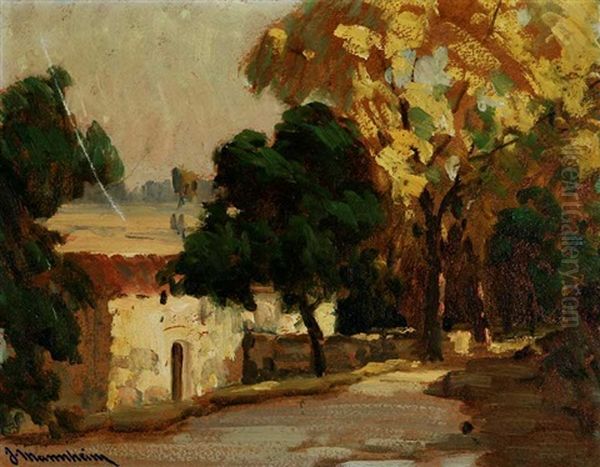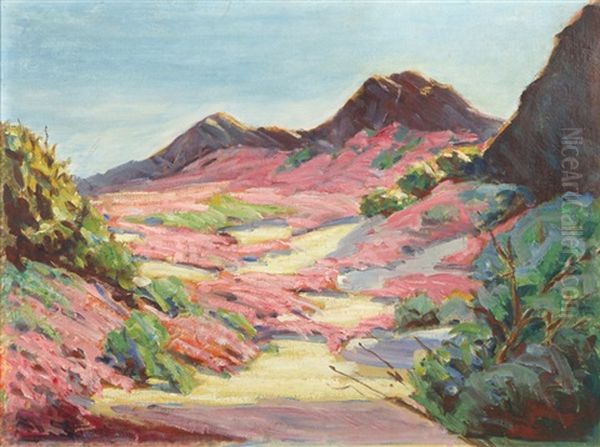Jean Mannheim stands as a significant figure in the narrative of American art, particularly within the vibrant chapter of California Impressionism. Born in Germany but finding his artistic voice under the expansive skies of the American West, Mannheim's life and work represent a fascinating confluence of European training and New World inspiration. As both a prolific painter and a dedicated educator, he left an indelible mark on the Southern California art scene, capturing its unique landscapes and contributing to its cultural development.
From the Rhine to the Seine: Early Life and Artistic Formation
Jean Mannheim entered the world on November 18, 1863, in Bad Kreuznach, a town nestled in the Rhineland region of Germany. His initial artistic inclinations were likely nurtured within his family, providing a foundation for his later pursuits. However, like many aspiring European artists of his generation, the allure of Paris, the undisputed center of the art world, proved irresistible. His formal training took place in the French capital, a crucible of artistic innovation and rigorous academic tradition.
In Paris, Mannheim sought instruction from respected figures of the time. He studied under William-Adolphe Bouguereau, a master of academic painting known for his idealized figures and polished technique. This exposure provided Mannheim with a strong grounding in draftsmanship and traditional composition. He also learned from Paul Delance and studied at the renowned Académie Julian, possibly under Rodolphe Julian himself. This academy was famous for attracting international students and offering a slightly more liberal environment than the official École des Beaux-Arts, exposing students to diverse approaches.
The Paris Mannheim experienced was a city buzzing with artistic debate. While he received academic training, the revolutionary waves of Impressionism, led by artists like Claude Monet, Pierre-Auguste Renoir, and Edgar Degas, had already reshaped the artistic landscape. Though his own style would evolve distinctly, the Impressionist emphasis on light, color, and capturing fleeting moments undoubtedly permeated the atmosphere and would resonate later in his career.
Across the Atlantic: Midwestern Interlude

In 1884, seeking new opportunities, Mannheim made the pivotal decision to immigrate to the United States. His journey initially led him to the American Midwest. He spent time in Chicago and later settled for a period in Decatur, Illinois. This phase was crucial not only for adapting to a new country but also for establishing himself professionally. He began to build a reputation, likely undertaking portrait commissions and exploring the local scenery through his art.
During his time in Illinois, Mannheim also embraced the role of an educator. He offered art instruction, sharing the techniques and perspectives he had acquired in Europe. This early teaching experience foreshadowed his later significant contributions as an educator in California. His teaching style reportedly began to blend the modern ideas encountered in Paris with a practical American approach, making art accessible and relevant to his students. The landscapes and culture of the Midwest, different from both Germany and Paris, likely offered new subjects and potentially influenced his palette and perspective before his final move west.
The Call of California: Pasadena and Impressionism
The year 1908 marked another significant relocation for Mannheim, one that would define the mature phase of his career. He moved to Pasadena, California, drawn perhaps by the burgeoning art community, the favorable climate, and the dramatic scenery that was attracting artists from across the country. Southern California was rapidly becoming a haven for painters captivated by its unique light and diverse landscapes, from sun-drenched coasts to rolling hills and majestic mountains.
Upon settling in Pasadena, Mannheim quickly became integrated into the local art scene. This was the era when California Impressionism was flourishing. This regional variant of Impressionism, while indebted to its French precursor, developed its own distinct characteristics. Artists focused intensely on capturing the brilliant, clear light of the region, often employing a vibrant, high-key palette and bold brushwork. The emphasis was frequently on the landscape itself – the eucalyptus groves, poppy fields, coastal vistas, and arid canyons that defined the California environment.
Mannheim emerged as a leading exponent of this style. He embraced the plein-air approach, painting outdoors to directly capture the effects of light and atmosphere. His work from this period exemplifies the key tenets of California Impressionism: a love for color, an energetic application of paint, and a deep appreciation for the natural beauty of his adopted home. He became a vital part of the artistic community that included notable figures like William Wendt, Guy Rose, Granville Redmond, Edgar Payne, and the husband-and-wife team of Elmer Wachtel and Marion Kavanagh Wachtel.
Capturing the Golden State: Style and Subjects

Jean Mannheim's artistic style is characterized by its confident brushwork, rich color, and strong sense of composition. While clearly rooted in Impressionist principles, his work often retains a solidity of form derived from his academic training. He possessed a keen sensitivity to the nuances of light and shadow, expertly rendering the atmospheric conditions of Southern California. His compositions are typically well-structured yet feel spontaneous and alive.
His subject matter was diverse, reflecting his broad interests and technical skill. Landscape painting, however, remained central to his output. He was particularly drawn to the ubiquitous eucalyptus trees of California, capturing their distinctive forms and the way light filtered through their leaves. Coastal scenes, rolling hills dotted with oaks, and pathways winding through sunlit groves were recurrent themes. Works like Eucalyptus and Path exemplify this focus, showcasing his ability to translate the specific character of the California landscape into paint.
Mannheim was also an accomplished portrait painter. His portraits ranged from formal commissions to more intimate depictions of friends, family, and interesting characters. He had a talent for capturing not just a likeness but also the personality of the sitter. Furthermore, he explored still life painting, often featuring vibrant floral arrangements or objects that allowed for a focused study of color, light, and texture. Goldfish Bowl and Flowers represents this aspect of his work, demonstrating his skill in handling complex arrangements and reflective surfaces. The painting Gypsy Dancer suggests an interest in figurative work beyond traditional portraiture, capturing movement and cultural character.
The Educator and Community Pillar
Beyond his own prolific output, Jean Mannheim made significant contributions as an educator and a central figure in the Southern California art community. Building on his earlier teaching experiences in the Midwest, he established himself as a respected instructor in Pasadena. He mentored numerous aspiring artists, sharing his knowledge and passion, and played a crucial role in fostering local talent. His teaching philosophy, combining European sophistication with American practicality, resonated with students.
Mannheim's influence extended beyond the classroom. He was deeply involved in the organizational life of the art community. He is considered one of the foundational figures associated with the California Art Club, an influential organization established to promote traditional art principles and provide exhibition opportunities for artists. His close friendship and professional association with William Wendt, another giant of California Impressionism often called the "Dean of Southern California artists," was particularly important.
Their relationship spanned nearly four decades, built on mutual respect and a shared commitment to artistic excellence. While Wendt focused heavily on organizing and leading artist groups like the California Art Club, Mannheim complemented this through his dedicated teaching and mentorship. Together, they formed a dynamic force, championing representational art and shaping the artistic landscape of the region. Their joint exhibitions, such as those held at the Friday Morning Club, were significant events, highlighting their prominence and the vitality of the local art scene.
Personality and Personal Life
Accounts suggest Jean Mannheim possessed a warm and engaging personality. He was known for his sense of humor and enjoyed telling stories, particularly drawing from his German heritage. This conviviality made him a popular figure within artistic circles. An interesting anecdote reveals his entrepreneurial spirit and perhaps his sociability: he reportedly opened a restaurant or gathering place with a "tavern" theme, which became a popular spot for fellow artists and local personalities, further cementing his role as a community hub.
His personal life provided a stable foundation for his artistic endeavors. He was married to Eunice Drennan, and the couple had two children, a son and a daughter. This familial aspect, while private, often subtly informs an artist's work and perspective, grounding their creative pursuits in the rhythms of everyday life. His ability to balance a successful artistic career, influential teaching activities, and a family life speaks to his energy and dedication.
Exhibitions, Recognition, and Later Years
Throughout his career, Jean Mannheim's work was featured in numerous exhibitions, gaining recognition both regionally and beyond. He exhibited at venues such as the Blanchard Gallery in Los Angeles and participated in shows connected to institutions like the Denver Art School. His regular participation in California Art Club exhibitions and other local shows ensured his work was consistently visible to the public and his peers.
His paintings were appreciated for their technical skill, vibrant depiction of California, and authentic artistic vision. While perhaps not achieving the same level of national fame during his lifetime as some East Coast Impressionists like Childe Hassam or William Merritt Chase, Mannheim was undeniably a major force in West Coast art. He garnered respect and admiration within the extensive network of artists working in California during the early twentieth century.
Jean Mannheim continued to paint and contribute to the art community throughout his later years. He passed away on September 6, 1945, in Pasadena, the city that had been his home and primary source of inspiration for nearly four decades. He lived to the age of 82, leaving behind a substantial body of work and a lasting legacy.
Enduring Legacy
Jean Mannheim's legacy resides in his beautiful and evocative paintings, which continue to be admired and collected today. His works serve as luminous documents of California's natural beauty during a period of significant development and artistic flourishing. They capture the essence of the California Impressionist movement – its optimism, its love of light and color, and its deep connection to the land. Artists like Franz Bischoff shared this love for vibrant color, while Granville Redmond uniquely captured the silence and beauty of poppy and lupine fields, often contrasting with Mannheim's frequent focus on trees and pathways.
Equally important is Mannheim's contribution as an educator and community builder. His dedication to teaching nurtured a generation of artists in Southern California, ensuring the continuation of artistic traditions and skills. His role in the early days of organizations like the California Art Club helped establish the infrastructure that supported artists and promoted art appreciation in the region. He stands alongside William Wendt, Edgar Payne, and Guy Rose not just as a painter of California, but as a shaper of its artistic identity.
In conclusion, Jean Mannheim was more than just a painter; he was a bridge between worlds – between his German origins and his American life, between European artistic traditions learned from masters like Bouguereau and the unique demands of capturing California light, and between his personal artistic practice and his commitment to fostering a vibrant arts community. His paintings remain a testament to his skill and sensitivity, offering enduring visions of the Golden State's landscapes, bathed in the warm, clear light he so masterfully depicted.